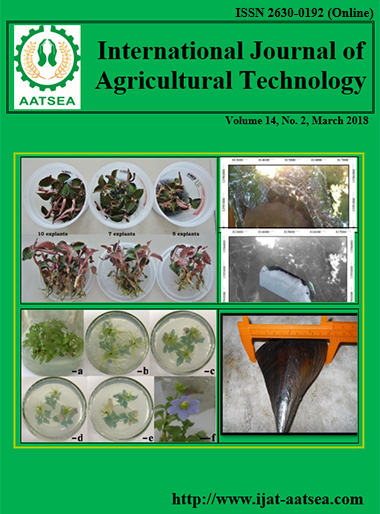The Bioactivities of Seed Coat and Embryo Extracts from Indian Gooseberry (Phyllanthus emblica)
Main Article Content
Abstract
The research evaluated the bioactivities of seed coat and embryo extracts from Indian gooseberry (Phyllanthus emblica Linn). The crude methanolic extract was further successively extracted with hexane, ethyl acetate, n-butanol and water by liquid-liquid partitioning method. The total phenolic content (TPC) in each solvent-extracted fraction was determined by Folin-Ciocateu method. The ethyl acetate seed coat extract possessed the highest TPC with values of 439.09±5.49 milligrams gallic acid equivalent (mgGAE)/g extract. The antioxidant activity of each extract was examined using ferric-reducing antioxidant power (FRAP) and 2, 2′-azinobis-(3-ethylbenzothiazoline-6-sulfonic acid) (ABTS•+) assay. The ethyl acetate seed coat extract revealed 50% inhibitory concentration (IC50 value) at a concentration of 31.53±0.36 microgram/milliliter (µg/ml) and ferric-reducing antioxidant power with 751.92±5.22 milligrams ascorbic acid equivalent (mgAAE)/g extract. The antibacterial activity of each extract was performed using disc diffusion method. The ethyl acetate seed coat extract demonstrated the greatest bacterial inhibition against Bacillus subtilis ATCC 6633, Bacillus cereus DMST 5040, Staphylococcus epidermidis ATCC 12228, Staphylococcus aureus TISTR 1466, and Micrococcus luteus ATCC 9341. These results suggested that the seed coat extracted with ethyl acetate could be served as a natural source of the bioactive compounds and used in the preparations of products such as drugs, anti-aging supplements, and cosmetics.
Article Details

This work is licensed under a Creative Commons Attribution-NonCommercial-NoDerivatives 4.0 International License.
References
Baliga, M. S. and Dsouza, J. J. (2011). Amla (Emblica officinalis Gaertn), a wonder berry in the treatment and prevention of cancer. European Journal of Cancer Preventio 20:225-239.
Beedessee, G., Ramanjooloo, A., Aubert, G. and Eloy, L. (2012). Cytotoxic activities of hexane, ethyl acetate and butanol extracts of marine sponges from mauritian waters on human cancer cell line. Environmental Toxicology and Pharmacology 34:397-408.
Cai, Y., Luo, Q., Sun, M. and Corke, H. (2004). Antioxidant activity and phenolic compounds of 112 traditional Chinese medicinal plants associated with anticancer. Life sciences 74:2157-2184.
Dabur, R., Gupta, A., Mandal, T. K., Singh, D. D., Bajpai, V., Gurav, A. M. and Lavekar, G. S. (2007). Antimicrobial activity of some Indian medicinal plants. African Journal of Traditional Complementary and Alternative Medicines 4:313-318.
Dinesh, M., Roopan, S. M. and Selvaraj, C. I. (2016). Photocatalytic degradation of nitrophenol using biologically active Phyllanthus emblica seed extract. Journal of Photychemistry and Phytobiology B 161:273-278.
Kumar, A., Singh, A. and Singh, B. (2014). Assessment of therapeutic potential of Phyllanthus emblica (Amla): a natural godsend. International Journal of Cell Science and Biotechnology 3:4-14.
Meerungrueang, W. and Panichayupakaranant, P. (2014). Antimicrobial activities of some Thai traditional medical longevity formulations from plants and antibacterial compounds from Ficus foveolata. Pharmaceutical Biology 52:1104-1109.
Mishra, P., Dutta, N. and Mahanta, C. L. (2015). Partial extraction and identification of phenolics in Amla (Emblica officinalis) seed coat powder. Journal of Food Science and Technology 52:6990-7001.
Mishra, P. and Mahanta, C. L. (2014). Comparative analysis of functional and nutritive values of amla (Emblica officinalis) fruit, seed and seed coat powder. American Journal of Food Technology 9:151-161.
Nadheesha, M. K. F., bamunuarachchi. A., Edirisinghe, E. M. R. K. B. M. and Weerasinghe, W. M. S. K. (2007). Studies on antioxidant activity of Indian gooseberry fruit and seed. Journal of Science of the University of Kelaniya Sri Lanka 3:83-92.
Namiesnik, J., Vearasilp, K., Kupska, M., Ham, K. S., Kang, S. G., Park, Y. K, Barasch, D., Nemirovski, A. and Gorinstein, S. (2013). Antioxidant activities and bioactive components in some berries. European Journal of Food Research and Technology 237:819-829.
Ngamkitidechakul, C., Jaijoy, K., Hansakul, P., Soonthornchareonnon, N. and Sireeratawong, S. (2010). Antitumour effects of Phyllanthus emblica L.: induction of cancer cell apoptosis and inhibition of in vivo tumour promotion and In vitro invasion of human cancer cells. Phytotherapy Research. 24:1405-1413.
Quy, D. D., Artik, E. A., Phuong, L. T., Lien, H. H., Felycia, E. S., Suryadi, I. and Yi-hsu, J. (2014). Effect of extraction solvent on total phenol content, total flavonoid content and antioxidant activity of Limnophila aromatic. Journal of Food and Drug Analysis 22:296-302.
Patel, S. S. and Goyal, R. K. (2012). Emblica ofcinalis Geart: A comprehensive review on phytochemistry, pharmacology and ethnomedicinal uses. Research Journal of Medicinal Plant 6:6 16.
Priya, G., Parminder, N. and Jaspreet, S. (2012). Antimicrobial and antioxidant activity on Emblica officinalis seed extract. International Journal of Research in Ayurveda and Pharmacy 3:591-596.
Saeed, N., Khun, M. and Shabbir, M. (2012). Antioxidant activity, total phenolic and total flavonoid contents of whole plant extracts Torilis leptophylla L. Complementary and Alternative Medicine 12:221.
Wong, C., Li, H., Cheng, K. and Chen, F. (2006). A systematic survey of antioxidant activity of 30 Chinese medicinal plants using the ferric reducing antioxidant power assay. Food Chemistry 97:705-711.
Verma, R. C. and Gupta, A. (2004). Effect of pre-treatments on quality of solar-dried amla. Journal of Food Engineering 65:397-402.


